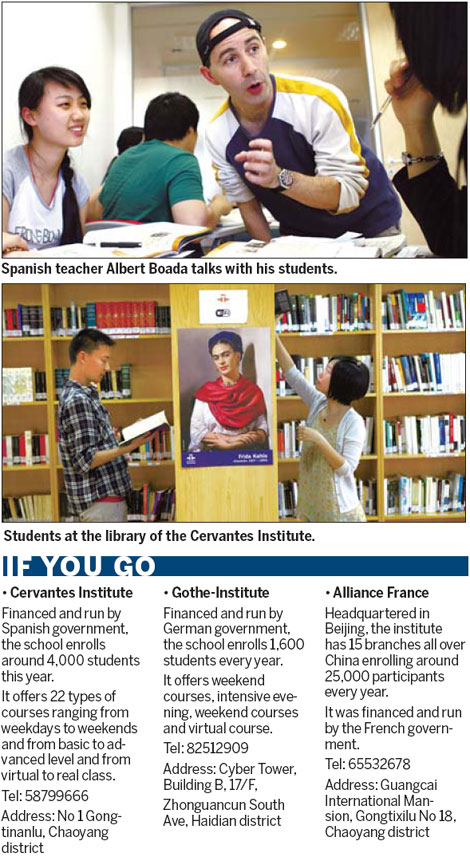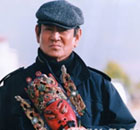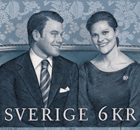Education
Talking up a teaching style
By Wang Wei and Huang Yuli (China Daily)
Updated: 2010-05-11 07:59
 |
Large Medium Small |
|
Teacher Katharina Forth and students during a class at the Gothe-Institute. [By Zou Hong / China Daily photos] |
Ma Yanan had no idea the Spanish he learned in school and had spoken for years would sound 50 years out of date on the streets of Madrid. The 21-year-old realized this when he enrolled in a Spanish course offered by the Cervantes Institute Beijing.
Ma, who is a junior at Luoyang PLA University of Foreign Languages University in Henan province, said the interactive course gave him much more than he ever got in school.
"Teachers here encourage me to speak up and I have learned more practical stuff," said Ma, who flew to Beijing in March for the two-month course in preparation for the DELE (Diplomas of Spanish as a Foreign Language) examination that takes place in the capital on May 22.
"The size of the class is much smaller," he said. "The maximum number of students we have in one class is 14, which leaves us with more potential to talk and learn."
Across town at the Goethe-Institute Beijing, 33-year-old Song Xiaobo has similar sentiments.
Having started to learn German so she could better communicate with her boyfriend (now fianc), Song studied initially at the German Chamber of Commerce for two months before shifting to the Goethe-Institute Beijing branch four months ago.
She likes the institute because classes are not limited to language teaching, but also offer information on the country and German culture.
"When our teacher told us about his youth, it helped me understand Germany much more," she said.
The institution organizes various activities, such as showing German movies and staging plays in the German language. She said the latest theatrical offering is Alladin.
With more and more students valuing interactive teaching techniques and courses that include background information in addition to hard facts, courses offered by foreign language institutes are seeing a healthy rise in admissions.
The Goethe-Institute Beijing branch was the first such foreign cultural institution established in the Chinese mainland and celebrated its 20th anniversary in 2008. The institution had a low profile in an old building within the Beijing Foreign Studies University when it began in 1988, initially teaching just 12 students.
Today, it is very well known and has a student population of about 1,600 each year since 2003.
Enrique Roldan, a public relations manager with the Cervantes Institute, told METRO the number of students on its books had more than doubled in the four years since its founding.
Initially, there were 1,168 students. The figure is expected to hit 4,000 by the end of the year.
Roldan attributes the growth in popularity to flexible courses and professional native-speaking teachers.
He said the institute offers 22 types of courses - ranging from weekdays to weekends, from basic to advanced level and from virtual to real classes - to meet the demand of different students.
The Spanish corner every Saturday afternoon, Cervantino film club every Sunday afternoon, flamenco dancing workshops and regular exhibitions and other cultural activities are also popular, he said.
Albert Boada, one of more than 30 Spanish-speaking teachers, believes an interactive and balanced teaching approach is the key to the institute's success.
Boada, formerly a teacher at the University of Barcelona, told METRO that Chinese students who learn the language at universities or in other training classes might be able to understand very complicated texts but sometimes are unable to have a simple conversation with a native speaker.
"We try to encourage students to speak up and don't correct them if they make only minor mistakes during the conversation," he said.
"We utilize movies, songs and role-playing extensively during classes to keep students interested."
Sabastian Voetter, a course expert with the Goethe-Institute, said its various cultural exchange programs were the big draw for most students.
Voetter was especially enthusiastic about the PASCH Project, a program that started in 2008 that brings German courses and German-Chinese cultural exchanges into middle schools.
The PASCH Project now has 35 partner middle schools in 18 provinces all over China, many of which had never before offered German courses.
The Goethe-Institute provides partner schools with teaching materials, teacher training in both China and Germany, testing and certification, summer camps for students in Germany and more.
Jiang Yiyi, a project assistant, said the program allows children from German and Chinese families to swap places for two months, during which time they will not only stay at each other's homes but go to each other's middle schools.
"This program was launched for the first time this year, so not only the kids but the staff too are very excited to see how it goes," Jiang said. "We're considering making a documentary film about it."
Clemens Treter, deputy director of the program, has worked at the institution in Beijing for five years and witnessed the growth of interest in its language programs.
"If the establishment of the Goethe-Institute more than 20 years ago opened a window to Germany, then what we are doing today is building a stage, a platform to bring German people and Chinese people together to communicate and interact."









